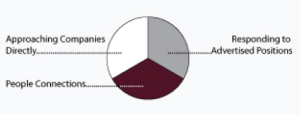Quick Ways to Improve Your Job Search Results
Job Searching: While job searching may not be your favorite activity, to continue to pay your bills, a successful job hunt is essential. And if you can make some easy changes that significantly improve your job search results, why not?
- Estimate how much time you’re investing in each of the primary job search activities: applying to help wanted employment ads, presenting yourself directly to potential employers, and networking with colleagues and acquaintances in your field.
To analyze your job search activity, use the records you’ve gathered, or do your best to recall your activities, answering these questions:
“What job search activities have I been using?” For instance, you may have been keeping your eye on help wanted employment ads that get posted, on company or temp-service web pages, or on Internet job search sites. These are the most common activities for most job searchers. You may also have been researching potential employers and presenting yourself to them directly, even though no job openings are advertised. Or you may be connecting with colleagues, friends, and support groups to learn about opportunities.
As you review your job search activities to this point, do your best to divide them into three categories:
- Responding to help wanted employment ads, such as those posted on Internet help wanted employment sites, in the newspaper, or on company or temp service websites.
- Approaching potential employers directly, even though no help wanted employment ad is advertised.
- Connecting with colleagues and groups through networking (such as on LinkedIn) to learn about opportunities in the market.
“How much time have I been spending on each of these job search activities each week?” Make a “best guess” estimate of how much job search time you’re putting into applying to help wanted employment ads, presenting yourself directly to potential employers, and connecting with others. Tip: be honest with yourself. No one is looking over your shoulder judging your situation. Our goal (yours and mine) is to get an accurate picture of what you’ve been doing, so that we can figure out how to make improvements that will get you the job search results you want. Here are a few guidelines for determining how much time you’re spending on each of these activities:
Estimate how much time it takes you to search for and locate help wanted employment ads to respond to, to customize a resume and / or cover letter for each help wanted employment ad, to fill out an online or hardcopy application form, and to submit and follow up on your materials. Based on the experiences of the job searchers I’ve worked with, a single application can take from between 5 minutes to 5 hours, so estimate what seems typical for you. Once you’ve determined the “per application” timeframe, multiply it by the average number of applications you respond to each week.
Determine how much time you devote to researching potential employers each week, and to approaching them directly. This may involve surfing the Internet to learn about companies, looking them up on LinkedIn, customizing a cover letter and / or resume, and then either mailing your materials or stopping by the company to drop them off. This activity may also include the time you put into following up on the materials you’ve submitted. Again, estimate your average “per company” timeframe, and multiply it by the number of direct approach attempts you complete each week.
Approximate how much time you spend connecting with people, including colleagues, friends, and groups, to uncover information about potential needs in the job market. Be sure to factor in the time you spend setting up connecting opportunities, talking with contacts, and following up on any opportunities you discover. Calculate the total time you devote to these connections weekly.
- Compare Your Activities to the “Ideal” Job Search Model
Now that you have a pretty good idea about how you’re spending you job search time each week, create a pie picture of your activities, using the circle below:
Based on my experience with job searchers, often, their job search activities pie will look like this:
Identify Some Potential Areas for Improvement
This next step won’t be rocket science: Evaluate your pie chart against this “ideal” pie chart of job search activities:
How did the two charts stack up? If you’re like most job searchers, you probably discovered that the majority of your time and effort in job searching are spent in responding to ads, and that approaching companies directly and connecting with people are pretty small in comparison. If this is the case, you can take comfort in knowing that there are some very simple changes you can make to your job search strategy that will produce much better results for you. We’ll cover these activities—and how to execute them—in the next several chapters. And before you know it, your pie chart (and your job search results) will improve significantly.
Excerpted and adapted from “Career Coward’s Guide to Job Searching” by Katy Piotrowski, M.Ed.




